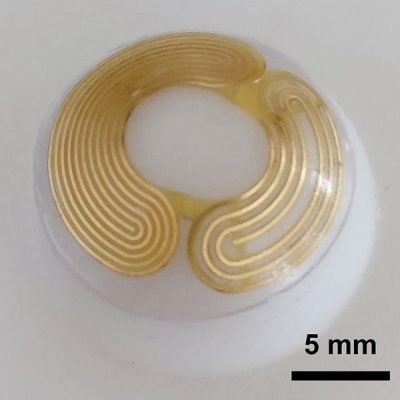Reviewed by Lexie CornerMay 10 2024
In a recent publication in ACS Applied Materials & Interfaces, scientists from the American Chemical Society unveiled a prototype "smart" contact lens capable of accurately measuring eye pressure irrespective of temperature fluctuations. This innovation holds significant promise for helping doctors diagnose glaucoma, particularly in detecting subtle elevations in eye pressure.
 This “smart” contact lens could someday help measure eye pressure and send wireless signals to enable early detection of glaucoma. Image Credit: ACS Applied Materials & Interfaces 2024
This “smart” contact lens could someday help measure eye pressure and send wireless signals to enable early detection of glaucoma. Image Credit: ACS Applied Materials & Interfaces 2024
Although early treatment is essential to reduce vision loss, the majority of people with early-stage glaucoma are unaware that they have the condition. Due to the range of temperatures that the eyes experience, it can be difficult to continuously monitor eye pressure.
According to the Centers for Disease Control and Prevention, glaucoma is a group of diseases that damage the optic nerve and can cause vision loss. In the United States, approximately three million people have glaucoma.
Doctors use flinch-inducing “air puff tests” to measure eye pressure during eye exams.
A diagnosis of glaucoma can result from a slight increase in pressure, an otherwise undetectable symptom of fluid accumulation around the cornea. Researchers have been experimenting with contact lenses that send signals to receptor glasses to more comfortably and continuously detect these minute variations in pressure.
However, temperature changes, such as going outside in cold weather, can impair the accuracy of the lenses' measurements. Therefore, Dengbao Xiao and associates set out to create a contact lens that could wirelessly transmit real-time signals about eye pressure across a broad temperature range and measure it accurately.
Xiao and the group first created two tiny spiral circuits, each of which had a distinct natural vibration pattern that would alter in response to minute strains, such as variations in the pressure and diameter of an eye. The researchers sandwiched layers of polydimethylsiloxane, a common contact lens material, between these tiny circuits to create pressure-detecting contact lenses. Then, by placing a coil close to the lens connected to a computer, they could wirelessly read the vibration patterns of the embedded circuits. Tests designed to mimic eye movement, prolonged exposure to moisture (to simulate damp conditions in the eye), and normal wear and tear did not affect the transmitted signals.
Three separate pig eye specimens were fitted with the new lenses in a lab setting where the ocular pressure and temperature were regulated. From 50 to 122 ℉, the contact lenses recorded and wirelessly communicated pressure data. The pressure calculation results using the signal from just one lens circuit varied by 87 % from the actual values.
However, because temperature-related errors were eliminated when data from both circuits was combined, the pressure readings varied by only 7% from the actual value. Even in a wide range of temperatures, the researchers believe that their dual-circuit "smart" lens design has potential for use in accurate early detection and monitoring of glaucoma.
The National Natural Science Foundation of China provided funding, which the authors acknowledge.
Journal Reference:
Li, X., et al. (2024) Temperature Self-Compensating Intelligent Wireless Measuring Contact Lens for Quantitative Intraocular Pressure Monitoring. ACS Applied Materials & Interfaces. doi.org/10.1021/acsami.4c02289.